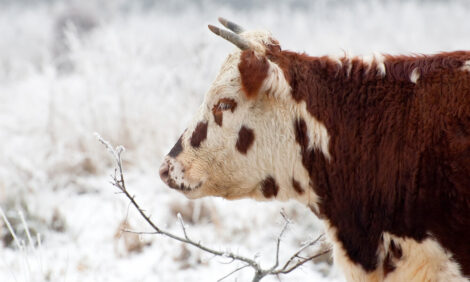



In The Cattle Markets
US - A weekly review of the cattle market by Darrell R. Mark, Ph.D., Assoc. Professor, Department of Agricultural Economics, University of Nebraska–Lincoln.Cattle Herd Smallest Since 1959
High feed grain prices, drought, and generally poor profit margins have resulted in the smallest cattle inventory since 1959. USDA released the results of its annual cattle inventory report on Friday, revealing another small decline in the total number of cattle and calves in the United States and the eleventh year out of the past fourteen with a herd reduction.
USDA estimated the total cattle inventory at 93.701 million head on January 1, 2010, 820,000 head less than January 1, 2009. While down 0.9 per cent, the drop in inventory wasn’t as large as the trade expected prior to the report’s release (average pre-release estimate was 98.5 per cent of last year). Several states with the large cattle inventories saw declines larger than the 0.9 per cent average: California, Iowa, Kansas, Missouri, Montana, Nebraska, and Texas.
Those same states saw declines in the number of beef cows too. For the US, beef cow inventory was estimated at 31.376 million head, one per cent lower than last year. As the beef cow herd continues to shrink, there has been little evidence of herd rebuilding to come during 2010. The number of heifers held for beef cow replacements was 5.436 million head, down 1.7 per cent from 2009. This decline in replacements was confirmed in the January Cattle on Feed report that showed an increased number of heifers on feed. What wasn’t expected in last week’s Cattle Inventory report was a 2.5 per cent increase in the number of heifers held for dairy cow replacements. Milk cow numbers were down 2.7 per cent, slightly more than expected, due to dairy cow slaughter increasing 9.2 per cent in 2009. The fact that dairy heifer replacement numbers increased relative to the year before demonstrates that milk producers are optimistic about profit opportunities in 2010 and beyond. It also seems to suggest that any long-term reduction in dairy cow numbers from last year’s buyout programs will be minimal.
USDA also estimated the 2009 calf crop at 35.819 million head, almost one per cent smaller than 2008 and the smallest calf crop since 1950. With such a small calf crop for the past couple of years, cattle feeders will likely find competition for getting those calves placed on feed this year. Further, it will result in excess capacity in feedyards. In 2009, cattle on feed numbers in US feedyards with more than 1,000 head capacities averaged three per cent lower than the previous five-year average. Last Friday’s Cattle Inventory report estimated the total number of cattle on feed (in feedyards of all sizes) at 13.642 million, down 2.5 per cent from January 1, 2009.
The market is expected to view the Cattle Inventory report as slightly bearish. While nearly all of the inventory categories showed declines relative to last year (about one per cent), the declines were not as large as the trade expected prior to the release (1.5 per cent).
The Markets
Last week’s fed cattle trade was lower in spite of a relatively friendly cattle on feed report to start the week with. The 5-Area fed cattle price averaged $0.58/cwt lower on a live basis and almost $3/cwt lower on a dressed basis compared to the week before. Trade developed on Thursday in Nebraska at dressed prices ranging from $135-136. Kansas live sales were mostly at $85/cwt and Texas saw some $86 cattle traded late on Friday afternoon. The weakness in cattle prices was primarily due to demand concerns as we enter the weakest demand month of the year (February). For the week, choice boxed beef averaged $3.55/cwt lower than the previous week and the Choice-Select spread narrowed by $1/cwt. Lower corn prices supported feeder calf markets. For the week, Nebraska and Oklahoma steer calf prices were steady to $2/cwt higher. Yearling weight steer prices were slightly weaker last week. Omaha, NE corn price continued its retreat, losing another $0.06/bu. DDGS prices were stronger and WDGS were weaker last week, trading at 86 per cent and 83 per cent of the price of corn on a dry matter basis, respectively.
|
Cattle or Meat Category
Data Source: USDA AMS Market News
|
Week of
1/29/10 |
Week of
01/22/10 |
Week of
01/30/09 |
|
|---|---|---|---|---|
| 5-Area Fed Steer | all grades, live weight, $/cwt | $84.42 | $85.00 | $80.71 |
| all grades, dressed weight, $/cwt | $135.64 | $138.38 | $129.62 | |
| Boxed Beef | Choice Price, 600-900 lb., $/cwt | $141.40 | $144.95 | $145.47 |
| Choice-Select Spread, $/cwt | $3.42 | $4.49 | $4.36 | |
| 700-800 lb. Feeder Steer Price | Montana 3-market average, $/cwt | $95.26 | $95.37 | $92.44 |
| Nebraska 7-market average, $/cwt | $99.68 | $100.08 | $94.50 | |
| Oklahoma 8-market average, $/cwt | $97.31 | $97.47 | $94.07 | |
| 500-600 lb. Feeder Steer Price | Montana 3-market average, $/cwt | $116.56 | $117.25 | $111.42 |
| Nebraska 7-market average, $/cwt | $120.15 | $118.33 | $116.26 | |
| Oklahoma 8-market average, $/cwt | $109.16 | $109.09 | $105.06 | |
| Feed Grains | Corn, Omaha, NE, $/bu (Thursday) | $3.41 | $3.48 | $3.68 |
| DDGS Price, Nebraska, $/ton | $110.70 | $109.90 | $143.20 | |
| WDGS Price, Nebraska, $/ton | $41.35 | $42.70 | $48.50 | |


